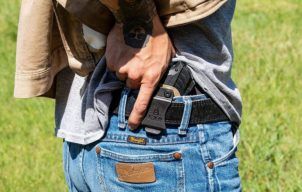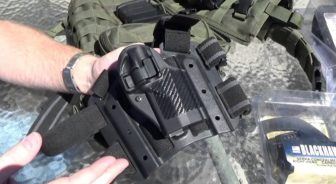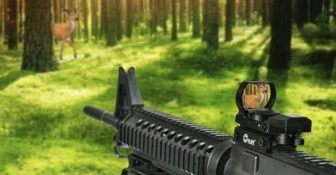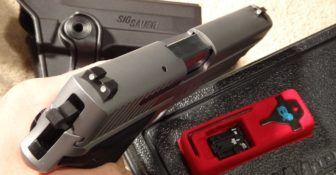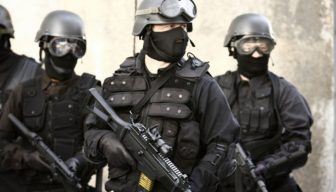10 Best Rifle Bipods of 2021
Photo: Caldwell
A rifle bipod is a resting place for your gun’s barrel. As the name suggests, it has two legs and it helps to support the rifle by reducing movement, which results in more stability and accurate shooting. The piece also reduces operator fatigue because it holds the gun’s weight at the front.
That said, these units are available in multiple sizes and with different features. To help you pick the most suitable piece, we have reviewed the best rifle bipods in the market that you can buy. Scroll through to read more and take your pick.
-
10 Best Rifle Bipods – Review
- 1. Best Overall Rifle Bipod: Caldwell XLA Pivot Bipod
- 2. Best Inexpensive Rifle Bipod: Bestsight Clamp-on Bipod
- 3. Best Lightweight Rifle Bipod: Cvlife Rifle Bipod
- 4. Best Rifle Bipod for Off-The-Ground Shooting: Twod Hunting Rifle Bipod
- 5. Best Tactical Rifle Bipod: Magpul Rifle Bipod
- 6. Best Rifle Bipod for All Hunting Environments: XAegis Rifle Bipod
- 7. Most Compact Rifle Bipod: UTG TL-BP98Q
- 8. Rifle Bipod for Large Rifles: Cvlife Rifle Bipod
- 9. Durable Rifle Bipod: Cvlife Tactical Rifle Bipod
- 10. Rifle Bipod with a Padded Base: Twod Rifle Bipod
- How to Buy the Best Rifle Bipods
- How to Install a Bipod on your Rifle
- How to Use a Rifle Bipod Properly
- FAQs
- Conclusion
10 Best Rifle Bipods – Review
|
IMAGE |
PRODUCT |
FEATURES |
|
|---|---|---|---|
|
|
1. Caldwell XLA Pivot Bipod (Best Overall) |
|
|
|
|
2. Bestsight Clamp-on Bipod (Best Inexpensive) |
|
|
|
|
3. Cvlife Rifle Bipod (Best Lightweight) |
|
|
|
|
4. Twod Hunting Rifle Bipod (Best for Off-The-Ground Shooting) |
|
|
|
|
5. Magpul Rifle Bipod (Best Tactical) |
|
|
|
|
6. XAegis Rifle Bipod (Best for All Hunting Environments) |
|
|
|
|
7. UTG TL-BP98Q (Most Compact) |
|
|
|
|
8. Cvlife Rifle Bipod (Ideal for Large Rifles) |
|
|
|
|
9. Cvlife Tactical Rifle Bipod (Durable) |
|
|
|
|
10. Twod Rifle Bipod (Padded Base) |
|
|
PRODUCT |
|---|
|
1. Caldwell XLA Pivot Bipod (Best Overall) |
|
2. Bestsight Clamp-on Bipod (Best Inexpensive) |
|
3. Cvlife Rifle Bipod (Best Lightweight) |
|
4. Twod Hunting Rifle Bipod (Best for Off-The-Ground Shooting) |
|
5. Magpul Rifle Bipod (Best Tactical) |
|
6. XAegis Rifle Bipod (Best for All Hunting Environments) |
|
7. UTG TL-BP98Q (Most Compact) |
|
8. Cvlife Rifle Bipod (Ideal for Large Rifles) |
|
9. Cvlife Tactical Rifle Bipod (Durable) |
|
10. Twod Rifle Bipod (Padded Base) |
1. Best Overall Rifle Bipod: Caldwell XLA Pivot Bipod
Photo: Caldwell
- Height: 6 – 9 inches
- Weight: 12 oz.
- Materials: Aluminum
- Attachment Method: Sling Swivel
At the top is Caldwell’s XLA pivot bipod and this is the overall best because it has a pivot function that allows you to level your gun on uneven surfaces or follow moving targets. It does so by tilting up to 20º on either side, which compensates for the unevenness.
Once you get to a comfortable level position, a tension knob is built-in to adjust the resistance of the pivoting motion. This helps to firmly secure the rifle at the set position so that you can fire accurately.
Additionally, the unit has conveniently notched legs that allow for easy, independent height adjustment from 6 – 9 inches. These can also be used to level your firearm.
That said, these legs spring out quickly at the push of a button for easy setup. They also fold up after use for easy and compact transportation.
The entire structure is made using aluminum and it has a slim profile that makes it quite compact. Other features include soft rubber feet for better stability and a padded non-marring base protects your rifle from scratches.
You also get a sling swivel stud that attaches to nearly all kinds of firearms, making it widely compatible. However, a Picatinny adapter is not included for perfect fitting on a rifle’s forearm.
Pros:
Cons:
2. Best Inexpensive Rifle Bipod: Bestsight Clamp-on Bipod
Photo: Bestsight
- Height: 6 – 9 inches
- Weight: 11.68 oz.
- Materials: Aluminum
- Attachment Method: Dragon Claw
If you are in the market for a high-quality, affordable bipod, we highly recommend this piece from Bestsight . Despite being this affordable, the unit is built using durable high-tech aluminum with stable rubberized feet and a cloth-padded base for scratch-free use.
The bipod also features a unique dragon claw attachment mechanism, which wraps around your rifle’s barrel and is adjustable in diameter (11-19mm) for perfect gripping.
You get spring-loaded, independently adjustable legs and these have a posi-lock to prevent tipping. These legs are foldable on your firearm for compact storage and transportation.
On the downside, the bipod lacks a Picatinny adapter and it does not have a pivoting function for leveling your rifle on uneven surfaces.
Pros:
Cons:
3. Best Lightweight Rifle Bipod: Cvlife Rifle Bipod
Photo: Cvlife
- Height: 6 – 9 inches
- Weight: 8.8 oz.
- Materials: Carbon Fiber
- Attachment Method: Sling Swivel, Picatinny Rail
Weighing in at only 8.8 oz., Cvlife’s rifle bipod is very lightweight, which makes it easy to carry. This is made possible by a carbon-fiber construction because the material is lighter than aluminum but stronger than steel.
On top of this, carbon fiber is temperature, friction, and corrosion resistant, which makes this piece very durable.
Aside from that, the unit is height adjustable from 6 – 9 inches and it has 5 settings (notches) on each leg for easy adjustment.
More features include rubber feet for stability, fore-end padding for protecting your rifle from damages, a sling swivel attachment mechanism, a Picatinny adapter for tight-fitting on Picatinny or Weaver rails, and a thumbscrew clamp for easy mounting/unmounting.
However, the piece does not tilt or pan to level your rifle on uneven surfaces.
Pros:
Cons:
4. Best Rifle Bipod for Off-The-Ground Shooting: Twod Hunting Rifle Bipod
Photo: Twod
- Height: 9 – 13 inches
- Weight: 11.92 oz.
- Materials: Steel, Aluminum
- Attachment Method: Sling Swivel, Picatinny Rail
With a height adjustment of 9 – 13 inches, this bipod offers some good ground clearance and this makes it ideal for off the ground shooting. Additionally, this height gives enough room for AR magazines so that you can use large, automatic firearms.
That said, these legs are held in place via spring tension control and are easily foldable after use for compact carrying. They also have a notched design for quick and accurate height adjustment.
The bipod is made using hardened steel and aluminum with a durable rust-free anodized finish for long-lasting use.
Other features include a sling swivel attachment and a Picatinny rail adapter for wide compatibility. However, the adapter does not pan or tilt for easy leveling on uneven ground.
Pros:
Cons:
5. Best Tactical Rifle Bipod: Magpul Rifle Bipod
Photo: Magpul
- Height: 6.3 – 10.3 inches
- Weight: 11 oz.
- Materials: Polymer, Aluminum
- Attachment Method: Picatinny Rail
Magpul’s rifle bipod has a tactical design that includes a total of 50º of tilting and 45º of panning. These adjustments allow you to move your rifle in real-time when aiming at a moving target. They also enable you to level your rifle on uneven surfaces for accurate shooting.
That said, the unit is optimized for rapid one-handed operation so that you can make all these adjustments quickly and easily while holding your rifle.
You also get a stabilizing forward tension with no exterior spring mechanism for easy loading and neat, streamlined exterior. This gives it a low-profile design, which when combined with its aluminum and injection-molded polymer construction, brings out an aesthetic look.
Other features include 4 inches of leg height adjustment (6.3 – 10.3 inches) at the push of a button, soft rubber feet, and a 1913 Picatinny mounting system. The only problem is that the piece is very expensive.
Pros:
Cons:
6. Best Rifle Bipod for All Hunting Environments: XAegis Rifle Bipod
Photo: XAegis
- Height: 6 – 9 inches
- Materials: Carbon Fiber
- Attachment Method: Sling Swivel, Picatinny Rail
With its carbon fiber construction, XAegis’ rifle bipod is fatigue resistant, corrosion, and temperature resistant. This makes it suitable to use in any hunting environment because it holds your rifle stably at all times.
Carbon fiber also makes the bipod lightweight for easy carrying while still being very sturdy. The material is lighter than aluminum but stronger than steel.
Each leg is independently adjustable from 6 – 9 inches with 5 notches for easy and accurate adjustment. These legs are connected to return springs for tension adjustment. This helps to hold them steady as you hunt and holds them in when folded.
More features include rubber feet for stability and a sling swivel attachment plus a Picatinny adapter for hooking up to different types of rifles. On the downside, the piece does not have concealed parts, which would result in a neat streamlined exterior.
Pros:
Cons:
7. Most Compact Rifle Bipod: UTG TL-BP98Q
Photo: UTG
- Height: 6 – 8.5 inches
- Weight: 13.8 oz.
- Materials: Steel, Aluminum
- Attachment Method: Sling Swivel, Picatinny Rail
UTG’s TL-BP98Q has adjustable legs that only go from 6 – 8.5 inches and this makes it very compact even when fully extended. That said, these legs are fully adjustable and they have 5 extension notches for securing them in the selected spot.
The unit is durably built because it has a heavy-duty steel and aluminum construction, which is coated in an anodized matte black layer for corrosion resistance. You also get rubber feet at the bottom for stability on the ground.
Other features include sling swivel and Picatinny rail attachments that can pan for rifle leveling on uneven ground, and a thumbscrew for precision adjustment.
However, despite being very compact, the bipod is quite heavy because it weighs 13.8 oz. It also lacks a posi-lock to prevent tipping.
Pros:
Cons:
8. Rifle Bipod for Large Rifles: Cvlife Rifle Bipod
Photo: Cvlife
- Height: 9 – 13 inches
- Weight: 12.48 oz.
- Materials: Steel, Aluminum
- Attachment Method: Sling Swivel, Picatinny Rail
Cvlife’s rifle bipod is adjustable height-wise from 9 – 13 inches and this gives you enough ground clearance to use it with a large rifle. More specifically, this leaves enough space to fit a large magazine, which is the one used by large firearms.
That said, the unit is built using hardened steel and aluminum, which forms a sturdy frame to support large, heavy rifles. This structure is coated in a black anodized finish for rust-free performance.
Springs on the legs make it simple to fold them up when not in use and this also keeps them tightly secured for silent hunting.
Other features include stable rubber feet, a quick attaching/detaching swivel guard, a Picatinny rail adapter, and rubber padding on the base to prevent damages on the rifle’s fore-end. On the downside, the piece does not have a pivoting base for rifle leveling on uneven ground.
Pros:
Cons:
9. Durable Rifle Bipod: Cvlife Tactical Rifle Bipod
Photo: Cvlife
- Height: 6 – 9 inches
- Weight: 10 oz.
- Materials: Steel, Aluminum
- Attachment Method: Sling Swivel, Picatinny Rail
This bipod also features a hardened steel and aluminum construction that gives it a very solid frame but relatively lightweight 10 oz. frame. Additionally, it has a rust-resistant black anodized finish for maximum durability and camouflage, especially in the dark.
Apart from that, the piece is fitted with a leg release button for easy adjustment from 6 – 9 inches, and each leg has 5 notches for adjusting to 5 different height settings.
A sling swivel stud and Picatinny adapter options are at your disposal for attaching your rifle while the mount tension screw is fitted with more threads for better strength to hold the tension.
More features are rubber feet pad for shock proofing and non-skid performance on different surfaces, and foldable arms with spring tension control. On the downside, the unit is not designed to pan on the mounting mechanism.
Pros:
Cons:
10. Rifle Bipod with a Padded Base: Twod Rifle Bipod
Photo: Twod
- Height: 6 – 9 inches
- Materials: Aluminum
- Attachment Method: Sling Swivel, Picatinny Rail
Rounding up the list is Twod’s rifle bipod and this one is characterized by a padded base that gives a soft-landing spot for your gun’s barrel. As a result, the rifle is protected from any damages such as scratches, especially during recoil.
The product also has soft rubber feet that keep your rifle steady on the ground by preventing skidding and absorbing most of the shock.
A sling swivel stud and Picatinny/weaver rail attachment methods are used for rifle mounting, which ensures you can hook it up to almost every kind of rifle.
You also get a leg release button for quick-extension, a thumbscrew clamp for easy mounting/unmounting, and a sturdy aluminum frame.
However, the piece lacks a posi-lock mechanism to prevent the legs from tipping while the base is fixed in position. This makes it a bit difficult to level your gun on uneven surfaces.
Pros:
Cons:
How to Buy the Best Rifle Bipods
Photo: XAegis
1. Compatibility
For a bipod to work, it must be compatible with your gun and this is checked in the attachment mechanism. The most common one is a sling swivel stud, which is particularly ideal for old traditional rifles. That said, these attach to almost any kind of rifle but don’t attach very firmly.
Picatinny/Weaver attachments are a better alternative because they attach the bipod to the rifle more securely.
There are other attachment methods like dragon claws but generally, we recommend bipods with both sling swivel studs and Picatinny adapters for maximum compatibility.
2. Height
6 – 9 inches
These are the smallest types of rifle bipods and they are ideal for shooting on benches . You can still use them on the ground but you must be in a prone position.
Additionally, their low profile means you can’t use them with large rifles that have long magazines. On the bright side, they are compact and easy to carry.
9 – 13 inches
9-13-inch bipods are the ideal units for shooting using guns with large AR magazines. This is because they provide the required ground clearance. They also allow you to shoot while comfortably while in a prone position off the ground.
13 – 24 inches
This height is quite tall and as such, it is ideal for shooters that are wearing body armor. The height is also ideal for hunting over deep snow or tall grass because your rifle will be held high above them.
25 – 62 inches
These tall bipods can only be used in a sitting or kneeling position and are ideal for areas with uneven surfaces (where you can’t set up in a prone position). For instance, on rocky ground or in the mountains, it is practically impossible to lie down, which leaves this as the ideal size to buy.
3. Independent Adjusting Legs
This is a must-have feature because it comes in very handy when shooting over uneven ground. In such a scenario, you can adjust one leg then leave the other as it is if positioned on a higher surface.
You should also look for notches for easy and accurate adjustment. The more the notches are, the better.
4. Materials Construction
Most bipods are made using metal like steel and aluminum, which gives a very solid structure. However, a few are made using carbon fiber, which gives the benefit of being both strong and lightweight. This material is lighter than aluminum and stronger than steel.
As such, we highly recommend such and the perfect example is Cvlife’s rifle bipod .
5. Panning and Canting
Panning is the ability of the base to tilt right or left while canting is the ability to move up and down. These movements are very important because they enable you to make micro corrections on the go as you aim at moving targets.
Without these, you will have to physically move your rifle plus the bipod, which would give your target enough time to escape from the field of view.
Even though these two features make bipods quite costly, they are worth it and that’s why we highly recommend Magpul’s piece .
How to Install a Bipod on your Rifle
Photo: Twod
If using a sling swivel:
- Loosen the bipod clamp by undoing the thumbscrew on the bipod’s bottom side.
- With the two pins exposed, direct them into the gun’s bipod stud mount.
- Once the pins are in the stud mount, tighten the thumbscrew until it is firm and that’s it.
If using Picatinny/Weaver rails:
- Unscrew the rail mount on the bipod, which is usually done using an Allen key.
- Once the jaws are wide enough, clasp them onto your rifle’s rail then tighten the screw.
NB: Don’t overtighten the screw. You might damage it.
How to Use a Rifle Bipod Properly
- If you are on soft ground, dig some holes then dip the legs inside for better shock absorption.
- Make sure you are directly behind the rifle.
- While in the prone position, push forward on the rifle to get some loading on the bipod. This will prevent it from rising due to recoil.
FAQs
1. Does a Rifle Bipod Affect Shooting Accuracy?
Yes, it does. A key factor that positively affects shooting accuracy is being in a comfortable position. A rifle bipod lets you position yourself comfortably almost anywhere so that you can aim and shoot with very little effort.
2. Are Rifle Bipods Universal?
This depends on the attachment method. Picatinny rail attachments are not universally compatible. They are usually compatible with new rifles. However, sling swivel studs are somewhat universal but don’t grab the rifle very firmly.
Conclusion
In conclusion, we recommend Caldwell’s XLA as the overall best rifle bipod because it pans 20º on both sides for easy aiming of moving targets. However, if you want a more tactical unit, check out Magpul’s piece because it has a 50º canting and 45º panning design.
The unit is quite expensive though so if you are a bit short on cash, Bestsight clamp-on bipod is an affordable option that is worth looking into.
